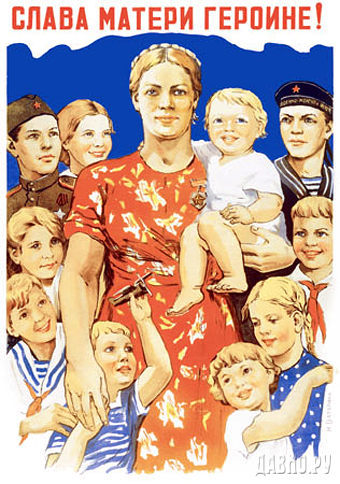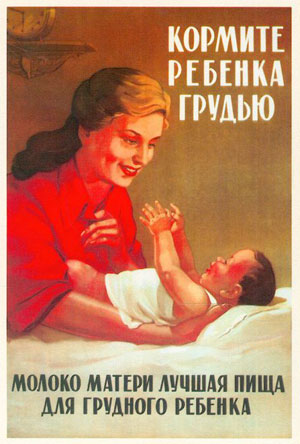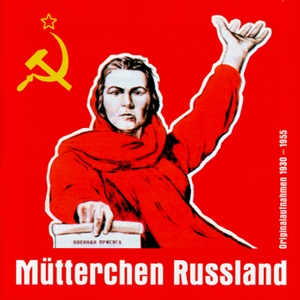Pronatalism and Population Management in Russia
This research guide provides a further study into the topic of pronatalism and population management in Russia specifically focusing on the changes that occurred in the state control of population during the period between the First and Second World Wars. This guide with look further into the changing idea of motherhood from the October Revolution of 1917 to the Stalinist period and how this took affect during the 1930s; transforming social pressures into state policy.
The October Revolution of 1917 brought with it high hopes for the liberation of woman. The radical Bolshevik government initially denounced the family and the institution of marriage, calling it a bourgeois institution. Yet by the 1930s Soviet Culture embraced the strong Soviet family; glorifying motherhood, and strove to dramatically increase the birthrate. Under Stalin, the Soviet government enacted polices that outlawed abortion and made it increasingly difficult to divorce.
Defining Pronatalism:
Definition:
- Pronatalism: domestic policy increasing the population by offering incentives to mothers to have as many children as possible.
- Definition from Wikipedia: http://en.wikipedia.org/wiki/Natalism
- “Natalism (also called pronatalism or the pro-birth position) is a belief that promotes human reproduction. The term is taken from the Latin adjective form for “birth”, natalis. Natalism promotes child-bearing and parenthood as desirable for social reasons and to ensure national continuance. Natalism in public policy typically seeks to create financial and social incentives for populations to reproduce, such as providing tax incentives that reward having and supporting children. Adherents of more stringent takes on natalism may seek to limit access to abortion and contraception, as well.”
Heitlinger, Alena. “Pronatalism and Women’s Equality Policies.” European Journal of Population / Revue Européenne de Démographie 7, no. 4 (1991): 343–375. http://www.jstor.org/stable/20164593.
- Great article to get a general definition on pronatalism and woman’s equality. The article examines various definitions of pronatalism and woman’s equality and looks into the policies surrounding them. Its goal is to determine which pronatalist policies are best-suited with policies pursuing women’s equality.
- Pronatalism “implies encouragement of all births as conducive to individual, family and social well-being…” it then can be seen as “operating on several levels: culturally, when childbearing and motherhood are perceived as ‘natural’ and central to a woman’s identity; ideologically, when the motherhood mandate becomes a patriotic, ethnic or eugenic obligation; psychologically, when childbearing is identified with the micro level of personal aspirations, emotions and rational (or irrational) decision-making (by women or couples); on the cohort level, when changes in the birth rate are related to the size of successive generations; and on the level of population policy, when the state intervenes, directly or indirectly, in an attempt to regulate the dynamics of fertility and to influence its causes and consequences.” (3)
Pronatalism in Soviet Russia:
Hoffmann, David L. “Mothers in the Motherland: Stalinist Pronatalism in Its Pan-European Context.” Journal of Social History Vol 34 No. 1 (2000): 35–54. http://www.jstor.org/stable/3789509.
- This article provides a great overview of pronatalism in Stalinist Russia, offering an important insight on the state’s ambitions to control reproduction and shape society. Sections including: Birthrates and National Power; Contraception and Abortion; Promoting Motherhood; and The Family and Paternal Responsibility examine how reproduction became a subject of rational study and scientific management in Soviet Russia.
- The article also dips its toes into the pronatalist tendencies of interwar Europe, arguing that the pronatalist interventions of the Soviet government were part of a broader trend of the state management of reproduction in Europe during the interwar period, though these governments perused population management in distinctly different ways.
David, Henry Philip. From Abortion to Contraception: A Resource to Public Policies and Reproductive Behavior in Central and Eastern Europe from 1917 to the Present. Vol. 1. Greenwood Publishing Group, 1999.
- This book does a great job of summarizing the abortion laws and the family planning policies in Central and Eastern Europe from the Russian Revolution to the end of the 20th century. David analyzes nine Eastern European countries separately covering trends such as abortion policies, illegal abortions, family allowance and tax policy, contraceptive methods and practices, family planning centers, population statistics, and relevant legislation.
- Relevant chapter “Russian Federation and USSR Successor States” with subsections including:
- Population Policy
- Abortion
- Abortion Registration and Surveys
- Contraception / Abortion
- The Woman Question
- The Woman Question
- Sex and Society
Berent, Jerzy. “Causes of Fertility Decline in Eastern Europe and the Soviet Union II: Economic and Social Factors.” Population Investigation Committee 24, no. 2. Population Studies (July 1970): 247–292. http://www.jstor.org/stable/2172658.
- This second part of Jerzy Berent’s study on the fertility decline in the Soviet Union deals more with the socio-economic differentials in fertility. He considers variables such as urban-rural residence, socio-occupational and employment status of women, educational attainment, income and housing conditions, and the consequent impact of structural changes in these characteristics of the population on observed fertility trends.
- Relevant to this research topic, the last section of this article deals with the impact of the fertility trends in post-war Russia and Eastern Europe. Focusing on employment and income. This leads into a discussion on the more recent pro-natalist measures introduced in the Soviet Union and their effectiveness.
Hoffman, David L. Stalinist Values The Cultural Norms of Soviet Modernity, 1917-1941. Ithaca NY: Cornell University Press, 2003.
- Stalinist leadership of Russia in the mid-1930s was committed to remaking both individuals and society. This book demonstrates that the Soviet state’s determination to improve society and bolster the socialist order by using selected elements of traditional culture and by intervening in the lives of its citizens. Hoffmann argues that this this mentality of state intervention was not unique to Soviet Russia, but remains distinctive because of it’s the collectivist orientation of official culture and the degree of coercion the state applied to pursue its objectives.
- The chapters specifically on “Stalinist Family Values” (and the sections entitled “Soviet Pro-natalism in Comparative Perspective” and “The Family as an Instrument of the State”) and “Social and Cultural Identity under Soviet Socialism” are especially relevant.
Lapidus, Gail Warshofsky. Women in Soviet Society: Equality, Development, and Social Change. University of California Press, 1978.
- This book offers an analysis of the motivations, mechanisms, and consequences of the official Soviet commitment to female liberation. Lapidus argues that Soviet policy towards the transformation of woman’s roles was done so as a way of tapping into major economic and political resources.
- This book offers an explanation as to why the Stalinist leadership abandoned the previous promise of woman’s liberation from the family in order to use female industrial and reproductive labor to the state’s advantage.
Goldman, Wendy Z. Women, the State and Revolution: Soviet Family Policy and Social Life, 1917-1936. Cambridge: Cambridge University Press, 1993.
- This book examines how Soviet womanhood played into the construction of the family. It explains the transition of the Bolshevik desire to reinvent the family into a retreat back to the more traditional role of the family. Goldman looks at the Soviet Family Policy, how this affected social life, and how Soviet woman determined the future of the Soviet family.
- Chapter 7 entitled “Controlling reproduction: Women versus the state” is especially useful for this topic.
Ewing, Tom. “Women in World History.” Roy Rosenzweig Center for History and New Media, 1996. http://chnm.gmu.edu/wwh/modules/lesson11/lesson11.php.
- This website is a wonderful resource for researching woman throughout history. The site provides a vast collection of primary sources (including newspaper articles, images, speeches, non-fiction, websites, art, court records, etc). It also offers teaching resources for professors and students as well as analytical and website reviews.
- The section titled ” Soviet Dictatorship: Primary Sources” looks at the implications of Stalinist policies on Soviet Woman by examining primary sources. The section first gives a great short background on the leadership of Stalin and then the situation of woman under Stalin. The site provides extensive newspaper clippings, drawings, and cartoons
- Then, for those interested the site offers a “Teaching” section in which is provides strategies for understanding and analyzing the sources as well as a lesson plan for high school students and questions based on the documents.
Stites, Richard. The Women’s Liberation Movement in Russia: Feminism, Nihilism, and Bolshevism, 1860-1930. 1978 Edition. Princeton: Princeton University Press, 1978.
- This book is extremely useful for researching the changes in the freedoms of the woman in Russia from the pre-Bolshevik period through Stalin’s regime. Stites discusses in great detail the feminist responses to the Bolshevik policies and how these changes affected gender politics in Russia. The large time frame Stites gives provides his readers with a great general history of how feminism existed in Russia and gives a broader picture of woman’s struggles throughout the period.
Background on the life of a Soviet Woman:
Library of Congress, “A Country Study: Soviet Union (Former).” Last modified July 27, 2010. Accessed November 9, 2013. http://lcweb2.loc.gov/frd/cs/sutoc.html.
- The Library of Congress compiles a large page of information on each country in the world, the Soviet Union’s page is very navigable and has extensive information and subsections on the Soviet Family and Soviet woman in various roles of society; providing a comprehensive insight into the life of woman in Soviet Russia.
- Relevant sections include:
- Gender and Family Roles
- Role of Women
- Male-Female Relationships
- Marriage
- Roles in Marriage
- Divorce
- Sex and Contraception
- Gender and Family Roles
- The Soviet Family
- Evolution of the Soviet Family
- Family Size
- Family and Kinship Structures
- Function of Family
Willis, David K. Klass How the Russians Really Lived. New York: St. Martens Press, 1985.
- This book gives a great insight onto how urban woman lived in post-war Soviet Russia. An entire chapter is devoted to daily life of the Soviet Woman and focuses on the struggles they faced. Great for a more in depth look into the lives of not only woman in Soviet Russia, but society as a whole.
Attwood, Lynne . Creating the New Soviet Woman : Women’s Magazines as Engineers of Female Identity, 1922-53. New York, NY, USA: Palgrave Macmillan , 1999.
http://site.ebrary.com.ezproxy.bu.edu/lib/bostonuniv/docDetail.action?docID=5001690
- This book explores the ways in which the Soviet ‘new woman’ was presented to society from the 1920s to the end of the Stalin era through examining how they were portrayed in popular magazines. Attwood uses the women’s magazines, Rabotnitsa (The Woman Worker) and Krest’yanka (The Peasant Woman) to explain the changes in how a woman dressed, acted, and were perceived socially, in the prewar and wartime periods of Soviet Russia. The book discusses the changes in the female image and role that occurred while Stalin was in power and the glorification of motherhood.
Engel, Barbara Alpern , and Anastasia Posadskaya-Vanderbeck. A Revolution of Their Own. Boulder CO: Westview Press, 1998.
- This anthology contains the stories of eight Russian women and offers a rare perspective into the hardships and personal lives of woman in the Soviet era. The authors interviewed eight women from different backgrounds to get a comprehensive look at the changes seen over the century as well as illuminate the harsh reality of daily life in the Soviet Union.
- This book is important to the topic of Pronatalism because it gives a firsthand account on family life, work, sexual relations, marriage and divorce, and childbirth and childbearing in the Soviet Union. It also talks specifically about abortion and the underground pursuit abortion after it was banned in 1936.
Pronatalism in a Broader Context:
Connelly, Matthew. Fatal Misconception: The Struggle to Control World Population. Belknap Press, 2010.
- An extensive (and slightly disturbing) text on humankind’s ‘quest’ to remake humanity though state control of the initiative to breed ‘better people.’ Connelly offers a global history of the movement to control world population.
Quine, Maria Sophia . Population Politics in Twentieth-Century Europe: Fascist Dictatorships and Liberal Democracies . Routledge, 1996.
- Focuses more on the Pronatalism of France during the Third Republic and Nazi Germany during the Third Reich but in the introduction gives a good overview of population management in Europe in the nineteenth century.
- The introduction entitled “Fears of ‘Over-Population’ and ‘depopulation’ in the Nineteenth Century” is especially relevant.




